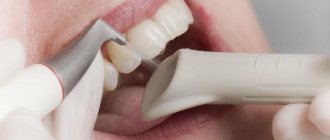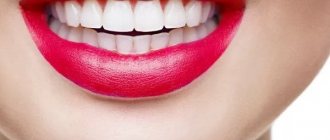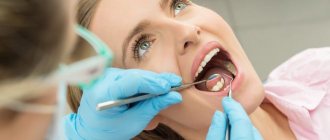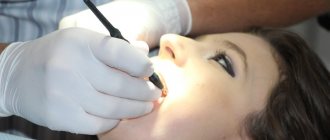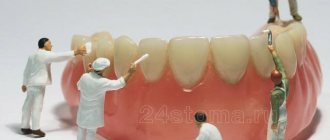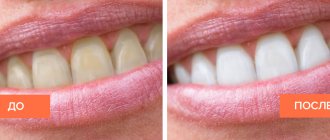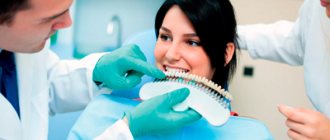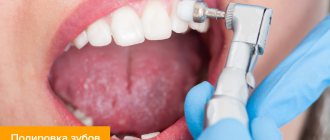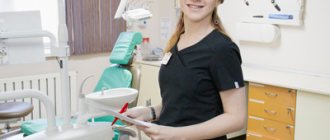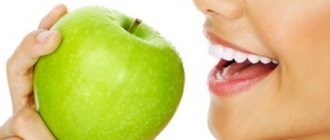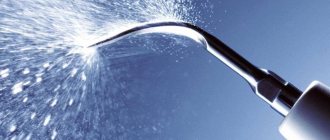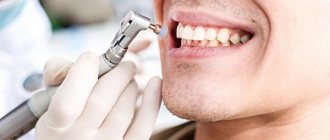- Hygienic teeth cleaning
- When is the best time to have your teeth professionally cleaned?
- Comprehensive professional teeth cleaning
- Professional teeth cleaning with ultrasound
- Cleaning teeth from plaque using the Air Flow method
- What is laser teeth cleaning?
- Manual teeth cleaning how the procedure is done
- Preventative care after comprehensive cleaning
- How and what to brush your teeth at home
- Our doctors
Plaque forms in the mouth due to harmful bacteria. If you do not take the necessary measures, this provokes the formation of tartar and the development of caries. Gum pathology may develop, leading to loosening and then tooth loss. To take care of their hygiene and health, professional hygienic teeth cleaning is necessary. To do this, it is worth visiting a dental clinic in Moscow.
The procedure effectively removes plaque, returns teeth to their natural white color, and prevents caries and gum disease. Professional care differs from home care in that the dental hygienist works with special tools. Plaque removal can be done in hard-to-reach places that a regular brush or even expensive toothpaste cannot do. The enamel layer is lightened by 1-2 tones, acquires a white color and a healthy appearance.
Deep hygienic dental cleaning prevents periodontal disease, damage to teeth by caries, their mobility, and loss.
When is the best time to have your teeth professionally cleaned?
You can tell when it’s time to see a doctor based on the following signs:
- an unpleasant putrid odor appeared from the mouth;
- the gums began to bleed, their subsidence was noticeable;
- itching or burning appears, pain is possible, especially when chewing food;
- tartar is visible visually;
- the color of the periodontium has changed.
Professional teeth cleaning will not harm your health, but there are contraindications:
- diseases of stomatitis, hepatitis, tuberculosis, as well as the presence of acute infections;
- the patient’s tooth enamel is too thin;
- intolerance to components used in cleaning;
- erosion, hypoplasia of tooth enamel.
Dental hygiene should not be done if the patient is under the age of eighteen. Professional hygiene is also contraindicated for HIV-infected people and AIDS patients. If there are diseases associated with difficulty breathing (asthma, epilepsy), sandblasting should not be carried out.
Comprehensive professional teeth cleaning
The hygienic procedure is carried out using various professional methods. In a dental clinic in Moscow, the professional technique is individual for everyone. Regardless of the choice, the procedure is carried out in several stages:
- The dentist examines the patient's oral cavity. Based on the examination, a treatment plan is drawn up. If teeth cleaning is needed, the types and methods are determined by the hygienist.
- Chemical cleaning and removal of soft plaque with a professional toothbrush is performed.
- Removing hard plaque depends on the professional method chosen.
- The dentist uses dental strips to clean the sides of the teeth and polish them.
- The enamel is polished on all sides, all irregularities are eliminated. For this purpose, dentistry uses special brushes and professional cleansers.
- Deep cleaning of teeth is completed by applying a solution containing fluoride to the surface. The composition is applied briefly. Professional fluoridation strengthens the enamel, since it is weakened by the action of tartar. Teeth should be fluoridated to reduce their sensitivity and to prevent caries. Fluoridation can be done as a separate procedure.
After the hygiene procedure, the dentist gives the patient recommendations for professional oral care. This allows the effect to last longer.
Cleansing in children
It is necessary to care for baby teeth just as carefully as for permanent teeth. Otherwise, teeth destroyed by the pathological process will cause the formation of a malocclusion.
How long should children brush their teeth? On average, the procedure takes 2 minutes. If it is difficult for a child to independently navigate the duration, then he can buy a brush with a timer or install a stopwatch on his mobile phone. These manipulations will make the oral care procedure more fun.
Professional teeth cleaning with ultrasound
If you influence tartar with ultrasonic waves, the process of getting rid of it becomes quick. The advantage of the ultrasound method is its antimicrobial and antibacterial effects.
Ultrasound is safe. Professional attachments are put on the emitter. They effectively remove plaque even in hard-to-reach areas. The result is exfoliation of tartar and its partial destruction. This is relevant when removing it from gum pockets - their treatment with an instrument can be painful and traumatic.
Thanks to ultrasound, such professional teeth cleaning guarantees a gentle effect on tooth enamel.
The hygienic procedure begins with exposure to an ultrasonic scaler at an angle. High frequency vibrations of ultrasonic waves remove deposits from the surface. At the same time, a flow of liquid is supplied. Together with ultrasonic vibrations, plaque and stone remains are washed away from periodontal pockets and interdental space. Hard tissues are lightened.
One session is enough to remove hard and soft deposits. Ultrasound teeth cleaning has almost no disadvantages. Exceptions to the effects of ultrasound - several contraindications:
- the presence of a pacemaker, severe cardiovascular disease or acute renal and hepatic failure in the patient;
- significant demineralization of tooth enamel;
- Ultrasonic teeth cleaning is prohibited if there is caries, which manifests itself in the form of multiple destructions;
- purulent diseases of the oral mucosa;
- the presence of orthopedic structures, especially metal ones.
Ultrasonic teeth cleaning has advantages:
- the versatility of the method, which allows ultrasound to remove deposits even in hard-to-reach places;
- antibacterial effect;
- no discomfort or pain during professional cleaning.
Cleaning teeth from plaque using the Air Flow method
Unlike the ultrasonic method, Air Flow is the effect of air flow together with an abrasive on hard plaque. The abrasive material is soda, which is applied along with a thin stream of water. Adding menthol or lemon flavors to water gives a refreshing effect. Small particles of soda hitting the enamel due to the air flow do not harm the teeth. They effectively cope with soft and hard plaque in gum pockets and interdental spaces.
Brushing your teeth with water reduces the heating of enamel during the hygiene procedure. This professional method helps in effectively removing plaque and tartar, and thoroughly polishes the enamel.
In addition to being used as a comprehensive approach, air brushing is suitable in the following cases:
- implants, crowns, and other orthodontic structures are installed in the mouth, as well as if braces or implantation are to be removed;
- problems with gums at the initial stage or there is plaque that has not yet turned into tartar;
- severe pigmentation of teeth due to smoking, coffee abuse and foods with dyes.
The professional Air Flow technique is safe and painless, has a gentle effect, and cannot cause an allergic reaction.
If preventive teeth cleaning is not carried out as part of a comprehensive procedure, the effect will be short-lived. For a more lasting result, it should be done about four times a year.
Types of dental floss
Flosses come in several types, because... Different people's teeth touch differently - for some they are very tight, crowded, for others the interdental spaces are standard or large. If the contact is too tight, standard floss simply will not fit into the gap, and if there is a large gap, it will be ineffective at cleaning. Therefore, consider the following classification of floss:
- according to the material of manufacture: nylon (can be covered with a film of polymers on top for greater strength) and polytetrafluoroethylene,
- by structure: there is a solid one - Oral-B Clinic Line, there is an intertwined one made of several fibers - for example, Oral-B Essential floss. There is also a super-floss (Oral-B Super floss), which has a stiffer and thinner tip, and the rest of the thread is soft, slightly fluffy. This product is suitable for those who wear braces, dentures, implants,
- with and without wax coating (“Wax” waxed and “Unwax” unwaxed thread): unwaxed thread is thinner, but glides worse, respectively, waxed thread is thicker and has better glide,
- by size (thread and ribbon): the thread is rounded, and the ribbon is flat and seems larger. But it is thinner than floss, so it may be the only option for people with tight contact between the teeth. The tapes are produced under the following brands: Oral-D Satin Floss, Colgate Total,
- with impregnation: fluorine compounds - for remineralization (strengthening and protection) of enamel. For example, Sensodyne Total Care. There are flavors - to freshen breath, with silver ions with an antibacterial effect - for example, SPLAT Dental Floss.
As a rule, all floss is supplied in flat spools, placed in a plastic case with a safety knife for cutting the thread. The floss is one-piece, and the user simply tears off the desired section before use. But, for example, super-flosses are sold in boxes, and each thread is separated from the rest. There is another option - automatic floss, when the thread is placed in a special device with holders, substitutes for “fingers”. The last option is a toothpick thread or flosser, also placed in a holder (it can be disposable or reusable). We'll tell you how to brush your teeth with each type of floss below.
“I have crowded teeth, so finding floss for them was a big problem. Even the thinnest unwaxed ones simply did not fit through. I once mentioned this to my dentist. They advised me that the tape was very thin, perfect for crowding. In fact, it turned out to be very comfortable, cleans well and glides well. It also contains fluoride, so your teeth become stronger.”
Marina97, review from woman.ru
What is laser teeth cleaning?
Laser therapy is based on the evaporation of liquid from plaque and deposits with a laser, after which the stones are destroyed layer by layer.
Hygienic laser cleaning does not involve contact of instruments with oral tissues. The professional technique is completely painless and has an antiseptic effect. The likelihood of an infection being introduced is zero.
Laser cleaning of teeth from stone gives the enamel a white color. Professional work effectively helps fight pathogenic bacteria and promotes wound regeneration. Prevention of caries is an additional advantage of the procedure. Contraindications to it are severe infectious and viral infections, asthma, epilepsy, as well as the presence of implants, orthopedic structures, and pacemakers in the patient.
A lasting effect will be ensured by teeth cleaning and fluoridation.
The fourth stage - fluoridation
As a rule, fluoridation is not included in the calculation of comprehensive professional hygiene, but it is very important for dental health. The application of fluoride helps strengthen the enamel layer (prevents the leaching of calcium), reduces hypersensitivity, prevents the onset of caries (slows down the proliferation of pathogenic bacteria). Therefore, you should not refuse this procedure. Fluoridation algorithm: the doctor dries the surface to be treated with a warm air stream, then applies fluoride varnish (a harmless composition based on varnish with a high concentration of fluorides) to each element of the dentition, then dries it.
Note: after completing all stages of comprehensive cleansing, teeth become noticeably lighter, reaching their natural natural color. But those patients who dream of a snow-white smile can resort to whitening, for example, using the ZOOM-4 method.
Manual teeth cleaning how the procedure is done
Dentists use the manual method as the last stage of a comprehensive hygiene procedure. It helps to manually remove the remains of tartar and plaque in places that are difficult to treat with dental instruments using ultrasound or laser techniques.
Manual hygienic cleaning of teeth is done using strips, curettes or dental floss. These instruments help the dentist eliminate mechanical and hardware processing errors in the space between teeth.
The use of polishing pastes enhances the effect.
Third stage - polishing
Deposits leave microcracks and irregularities on the enamel layer. Therefore, polishing is necessary after cleaning procedures. Otherwise, the remaining roughness will become a “magnet” for microparticles of food, which will very quickly turn into new deposits. Polishing is performed using abrasive pastes and various attachments driven by a drill. These are polishers, brushes, discs, needle-shaped attachments. The interdental areas are polished with special strips. The process does not cause pain and takes about 40 minutes.
Preventative care after comprehensive cleaning
Dentists consider bleeding gums and tooth sensitivity to cold and hot irritants after mechanical intervention to be normal. Usually these symptoms disappear after a few days. They are caused by damage to soft tissue. If they become inflamed as a result of treating subgingival areas, dentists recommend preventive treatment.
Mechanical brushing of teeth can also lead to irritation and swelling of the mucous membrane. On the first day after it, you should not consume foods with spices, dyes, coffee or tea. It is recommended to quit smoking.
The rule of hygiene is brushing your teeth before breakfast or after eating.
To strengthen the enamel and prevent the formation of deposits, the dentist applies professional products after the procedure. If your gums are inflamed or bleeding, you should not touch the inflamed areas with your hands. To maintain hygiene, it is better to use cotton swabs.
Brushing your teeth at home using a soft toothbrush and rinsing your mouth with decoctions of oak bark, chamomile or sage promotes rapid recovery. Dentists recommend brushing your teeth first and then having breakfast. In the evening, you should brush them just before going to bed. Additionally, you should use floss.
How many times a day should you floss?
How often should I floss? It is optimal if it is used after every snack or standard meal. Those. several times a day. But there is not always such an opportunity or time. At a minimum, you can use floss 1-2 times a day, and always in the evening before going to bed, in order to effectively remove all food debris and prevent the risk of developing caries. Moreover, the frequency of flossing is the same for both adults and children (it can be used from about 6-7 years old, when the bite begins to change).
How and what to brush your teeth at home
There are many ways to maintain hygiene at home for preventive purposes. When choosing them, you can use your doctor’s recommendation or take into account your own preferences.
- Brushing your teeth with toothpowder or paste using a regular toothbrush. The powder is suitable for daily hygiene after breakfast and before bed. The bristles of the brush should be of medium hardness. Preference should be given to artificial ones - microorganisms do not multiply on them. The powder loosens tartar and whitens the enamel.
- Brushing your teeth with a sonic brush with replaceable heads allows you to remove plaque in hard-to-reach places. A sonic brush cannot cope with dense tartar. Its action is based on rotational pulsating movements. They allow you to gently loosen deposits and sweep them out of your teeth. An alternative option for a sonic brush is an ultrasonic one. It generates ultrasound, with which it removes plaque and neutralizes the harm of bacteria.
- Brushing your teeth with an irrigator helps remove food debris after breakfast and removes plaque. The irrigator operates using a jet of water supplied under pressure. The device is easy to use. Professional attachments for the irrigator allow you to perform deep cleansing of areas that a toothbrush cannot penetrate.
- Brushing your teeth with a brush makes it possible to efficiently clean the interdental space. The effectiveness of brushes is higher than that of toothpicks and floss. They are suitable for people with dentures or braces. The use of brushes prevents damage to gums and tooth enamel.
- Brushing your teeth with ash will help make your smile snow-white. The ash must be rubbed into the teeth. After this, you can start cleaning. Using activated carbon or ash at home is the most inexpensive way to care for your oral cavity without visiting the dentist.
- Brushing your teeth with clay helps with bleeding gums. Powdered clay is a natural product that does not contain harmful substances. Brushing your teeth with white clay is an effective way to remineralize and strengthen tooth enamel.
- Brushing your teeth with coconut oil does not have a whitening effect. Coconut oil only destroys bacteria and returns the natural shade of enamel. Due to the beneficial properties of coconut, coconut oil strengthens gums, protects against caries, and eliminates bad breath. The main benefit of pulling coconut oil in your mouth is detoxification of the body.
Judging by patient reviews, hygienic teeth cleaning not only gets rid of plaque and stones. It prevents the development of caries and pathogenic microflora, and helps in the care of orthodontic structures.
Dentistry does not stand still. For patients with sensitive teeth who experience pain during brushing, the procedure is performed under local anesthesia.
